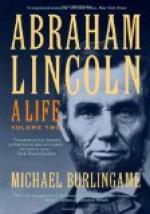To carry out this plan Swell’s corps was covertly moved early in June into the Shenandoah Valley. Hooker, anticipating some such scheme, had suggested to Mr. Lincoln that, if it were entered upon, he should like to cross the river and attack the Southern rear corps in Fredericksburg. The President suggested that the intrenched Southerners would be likely to worst the assailants, while the main Southern army “would in some way be getting an advantage northward.” “In one word,” he wrote, “I would not take any risk of being entangled upon the river, like an ox jumped half over a fence and liable to be torn by dogs front and rear, without a fair chance to gore one way or kick the other.” Yet, very soon, when the attenuation of Lee’s line became certain, Lincoln sent to Hooker one of his famous dispatches: “If the head of Lee’s army is at Martinsburg, and the tail of it on the plank road between Fredericksburg and Chancellorsville, the animal must be very slim somewhere. Could you not break him?” But the “animal” was moving rapidly, and the breaking process did not take place.
Hooker now conceived a plan seductive by its audacity and its possible results. He proposed by a sudden movement to capture Richmond, presumably garrisoned very scantily, and to get back before Lee could make any serious impression at the North. It might have been done, and, if done, it would more than offset all the dreary past; yet the risk was great, and Mr. Lincoln could not sanction it. He wrote: “I think Lee’s army, and not Richmond, is your sure objective point. If he comes towards the Upper Potomac, follow on his flank and on his inside track, shortening your lines while he lengthens his; fight him, too, when opportunity offers. If he stays where he is, fret him, and fret him.”
This was good strategy and was adopted for the campaign. Ewell’s corps crossed the Upper Potomac, and on June 22 was in Pennsylvania. The corps of Longstreet and Hill quickly followed, and Lee’s triumphant army, at least 70,000 strong, marched through the Cumberland Valley to Chambersburg and Carlisle, gathering rich booty of herds and grain as they went, with Harrisburg as an immediate objective, Philadelphia in no remote distance, Baltimore and Washington in a painfully distinct background. The farmers of western Pennsylvania, startled by the spectacle of gray-coated cavalry riding northward towards their state capital, cumbered the roads with their wagons. The President called from the nearest States 120,000 militia. General Hooker, released from his waiting attitude by the development of his adversary’s plan, manoeuvred well. He crossed the Potomac at Edwards’ Ferry, June 25-26, and drew his forces together at Frederick. It was then decided to move northward and to keep Lee as well to the westward as possible, thereby reserving, for the bearing of future events, the questions of cutting the Confederate communications or bringing on a battle.




